1
Before logs could be made into paper, they had to be barked and cut to size to fit the grinders. Smaller logs (26 inches or less) were put through the chipper to make chips for the sulphite mill.The Company's sawmill-barker mill was a concrete structure, unusual in the early 1900's. It contained a 9-foot diameter band-headsaw; the blade, which required changing and sharpening every four hours, was 64 feet 7 inches long and 16 inches wide. There was a 5-saw edger, a 7-saw slasher, eleven 84-inch disc hand barkers, two chippers and a rotary chip screen. A log haul conveyed the logs from the water into the mill. A conveyor carried bark and other wood refuse to the steam plant for burning.
Groundwood pulp was cheap to produce. Wood blocks were loaded into mechanical grinders and hydraulically pressed against rapidly revolving grindstones. A water spray kept the grindstones cool, lubricated them and carried away the pulp, which emerged hot and thick as porridge. After coming from the grinders, the pulp was highly diluted with water and run through screens to remove splinters and bundles of unseparated fibre, which were reground and put through the screens again. Before the stock from the screens was mixed with sulphite pulp, much of the water was removed from it by the deckers.
The Powell River Mill Story
2
Up the Log Haul20th Century
Powell River, British Columbia, Canada
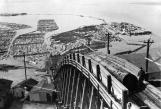 Credits:
Credits:FC045
Leonard Frank, photographer
Leslie Adams
3
It was an interesting job. There were lots of times when we were cutting special wood - like Queen Charlotte Spruce - we cut that during the war, they were particular about that. When they called for QCS, you had to be there and have the logs ready, and some of them were big - some were 8 or 9 feet across.We had a big slip, with chains in the bottom with dogs on it. And a pulley on each end - one in the saw mill and one down where the water was. And that kept that chain going all the time for logs. You'd just push them in there and the hooks on the lengths of the chain they'd hook into a log and pull it right up and slip it into the sawmill. And up in the saw mill, they had a power saw there. They had a circle saw there and a big steam drag saw. So if you had big timber you could use the big steam drag saw, but if you just had ordinary 2-foot logs, then you used the circle saw. Then at the head of the slip, they had a man who kept track of all the timber that went up the side of it, and how much timber was in it and everything.
Log Pond worker
Taped interview
People of the White City
4
Guiding LogsCirca 1926
Powell River, British Columbia, Canada
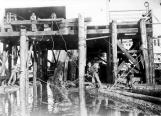 Credits:
Credits:P04644
Catalyst Paper, Powell River Division
Oren Olson
5
In the saw mill I started out as an off bearer. The carriage comes along, and the log is on it. And slabs are cut off the log as it comes along. That slab has got to be cut side down. You can't have it coming over on you because you'd have a mess on the rollers and the chains. You'd have to stand there and everytime the carriage came over and cut the slab off the log, you'd have to grab it with a peevie.Dino Aprilis, Woodroom
Taped Interview
People of the White City
6
Working the log carriage6 July 1949
Powell River, British Columbia, Canada
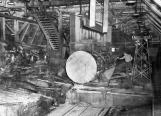 Credits:
Credits:P01619
Catalyst Paper, Powell River Division
Dino Aprilis
7
Next in line come the big 60-foot six-inch breakdown band saws, which saw the log into wide slabs ready for the twin and edger saws, each 37 feet long. These, in turn, saw the log into long strips approximately eight inches wide; ready for the "Slashers", which cross-cut the strips into 32-inch blocks. "Slasher" saws are circular, 30 inches in diameter and arranged in two lines of nine each.Powell River Digester
Vol. 25, No. 3
May-June, 1949
8
Log CarriageCirca 1940
Powell River, British Columbia, Canada
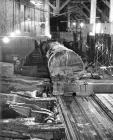 Credits:
Credits:P01649
Powell River Studio
Dino Aprilis
9
Riding the CarriageThat left hand carriage was driven by a big steam cylinder. I sat on that carriage when it got out of control. That thing would do 40 miles an hour from a standing start from the centre to the bumper. It was doing 40 miles an hour when it hit the bumper, and I was on it when it hit the bumper. When it came back for a second go at it, I jumped out of the seat, but I couldn't get off, so I hung on to the seat, and I got a great big bruise on my arm when I hit it again, and then I got off. The sawyer that was sawing, what had happened was that we had a tail sawyer who had dropped a slab backwards. The sawyer was bringing the carriage forward so the guy could flip it onto the carriage and take it off properly. But he didn't notice that the back bunk on the carriage had hooked onto the log. And when he brought the carriage ahead he was looking at the tail sawyer, but it actually came ahead and slammed against the lever and locked that carriage full ahead. He was knocked out and we both finished up at the hospital that night. They can get out of control in a hurry.
(The danger) was part of the job. The following day I was back on the job. I imagine we didn't think about (the danger) as much.
Saw mill worker
Taped interview
People of the White City
10
Riding the Carriage6 July 1949
Powell River, British Columbia, Canada
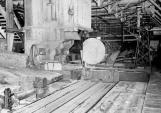 Credits:
Credits:N08167
Catalyst Paper, Powell River Division
Bob McGougan
11
Some of the bark it didn't come off, so they had men at the end of this thing letting the wood that was clean go either to the flume or the chipper. The wood that wasn't clean, they had to pull off in a conveyor and use the hand barkers. There were 4 or 5 of these hand barkers--huge things that had a big disc on them with knives on them. And a man had to hold the wood either mechanically or with their fingers.Dino Aprilis, Woodroom
Taped Interview
People of the White City
12
Hand BarkingCirca 1944
Powell River, British Columbia, Canada
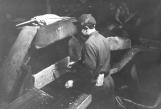 Credits:
Credits:P05250
Catalyst Paper, Powell River Division
Dino Apilis
13
A 48-inch Hansel Ring Barker was finally chosen. The in feed and out feed conveyors at the barker will consist of H chain with attachments for centering the logs. The roll cases and chain conveyors feeding the barker will be fully reversible. The roll cases will be arranged to travel at 180 feet per minute. The chain conveyors will have variable-speed drives to run at from 50 to 120 feet per minute depending on log size and relative ease of barking. The barker will be provided with both horizontal and vertical movement to adjust its location to suit varying log diameters and bowed logs. It is anticipated that a log of maximum diameter of 44 inches will be passed through the barker. Though designs generally have been based on 36-in-diameter logs, nothing has been done to prevent the passage of an occasional log over 36 inches and up to 44 inches in diameter.Water for the barker will be passed through three AWF 116 Adams Poro-Stone Automatic Back Flushing Water Filters.
Initial barking pressure will be 1,325 pounds per square inch. It may possibly be increased to at least 1,450 pounds per square inch, in line with similar existing installations.
Canadian Pulp and Paper Magazine
July, 1952
14
Ring BarkerCirca 1946
Powell River, British Columbia, Canada
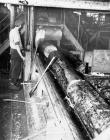 Credits:
Credits:P01645
Catalyst Paper, Powell River Division
Dino Aprilis